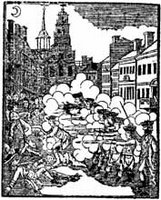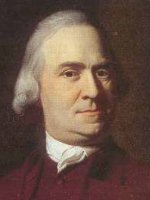“They Called Us Young Rebels.”
Back in November 2006, I quoted two letters from late January 1775, describing how Boston’s schoolboys had confronted Gen. Frederick Haldimand over their freedom to ride their sleds on an icy slope outside his house. Those letters weren’t published until the late 1800s, but Bostonians also passed on the anecdote orally between the Revolution and the 1840s.
As usually happens, without solid documentation the story became distorted over time. When Benson J. Lossing included a version of the tale in his volume Seventeen Hundred and Seventy-Six (1847), he evidently understood that it had happened in 1770 and involved Gen. Thomas Gage rather than his second-in-command.
This month, I found that Lossing had picked up his version of the dialogue between the boys and Gage from Samuel Griswold Goodrich’s school textbook The First Book of History, for Children and Youth. The edition available on Google Books is dated 1849, but the book was first published in Boston before 1845, and perhaps as early as the 1830s. (Goodrich had the annoying habit of giving the same title to different books and different editions.)
Here’s Goodrich’s version, with the paragraphs numbered for reading aloud in a classroom, I suspect:
15. Meanwhile, the jealousy of the people toward the soldiers continued to increase. Even the children caught the general feeling, as a story will show you. During the winter, before the Port Bill passed, the boys were in the habit of building hills of snow on the Common, and sliding down upon them to the pond. The English troops beat down these hills, merely to provoke the children. The boys complained of the injury, and set about repairing it. However, when they returned from school, they found the snow hills beat down again.Goodrich had heard a tale with several errors. “The winter, before the Port Bill passed,” was the winter of 1773-74, when there were no British regiments patrolling Boston. The 1775 sledding site was down Beacon Hill onto School Street, not on the Common; that didn’t become the town’s main sledding area until the 1800s. The contemporaneous letters say nothing about “hills of snow” or a “skating ground.” But at heart it’s clearly the same story that Boston Patriots had enjoyed in 1775.
16. Several of the boys now waited upon the British captain, and informed him of the conduct of his soldiers; but he would have nothing to say to them; and the soldiers were more impudent than ever. At last, they called a meeting of the largest boys, and sent them to General Gage, commander-in-chief.
17. He asked why so many children had called upon him. “We came, sir,” said the tallest boy, “to demand satisfaction.” “What!” said the general; “have your fathers been teaching you rebellion, and sent you to show it here?” “Nobody sent us, sir,” answered the boy, while his cheek reddened and his eye flashed; “we have never injured or insulted your troops; but they have trodden down our snow hills, and broken the ice on our skating ground. We complained, and they called us young rebels, and told us to help ourselves if we could. We told the captain of this, and he laughed at us. Yesterday our works were destroyed for a third time; and, sir, we will bear it no longer.”
18. The general looked at them with admiration, and said to an officer at his side, “The very children draw in a love of liberty with the air they breathe.—You may go, my brave boys; and be assured, if my troops trouble you again, they shall be punished.

This image of the meeting between the schoolboys and a general comes from an 1878 schoolbook by Goodrich, one of several graphic depictions of the story from the late 1800s.
There might be an even earlier version of this story in print. In his memoir A New England Boyhood (first published 1893), Edward Everett Hale wrote:
Mrs. Child, in her Juvenile Miscellany, gave the impression that the coasting scene, in which the Latin School boys defied General Gage, began with coasting on the Common. But she was wholly wrong there. . . . The story was told me by Mr. Robins, the last survivor of the delegation, in the year 18—.Hale, born in 1822, had enjoyed Lydia Maria Child’s magazine Juvenile Miscellany until she came out as an Abolitionist. Had she published a version of the sledding story? Or had Hale read it in Goodrich’s schoolbook but misremembered the source as Child’s magazine? (Hale was mistaken in trusting Jonathan Darby Robins on this story; that man had left the South Latin School well before 1775, and therefore was unlikely to have been “the last survivor of the delegation” to Gen. Haldimand.)
I’m still looking for a Juvenile Miscellany version of the sledding tale. Unfortunately, since that magazine was published for children (and edited by a woman, yet), there are few complete collections in libraries and no indexes. I’ve checked biographies of Child and books that she assembled from her magazine material. No luck yet.




